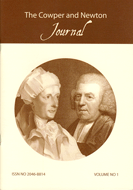Over the past 12 months (2003-4) the Cowper and Newton Museum
has been active on its own behalf in acquiring significant objects for
the collection, and fortunate in receiving donations from well-wishers.
Here are the stories of two of them.
Portrait of Mary Unwin (1724-1796) by Arthur Devis
An engraving based on this portrait has been displayed in the Museum
for many years. However, it was not until the art historian Simon Houfe
located the original, and alerted the Museum, that we became aware of
its existence. He had come across it on a visit to Knightshayes Court,
Tiverton, Devon, for centuries home of the Heathcoat-Amory family and
now a property administered by the National Trust. It proved difficult
to arrange for a photograph
to be taken of the picture to
the Trust’s exacting standards
until one of our Trustees, Joan
Jones, whose daughter works at
Knightshayes, made personal
contact with the House Manager,
Laura Beresford. Laura
enthusiastically got behind the
project and rapidly arranged
for a high-quality transparency
to be created and supplied to
the Museum. We contacted the
photographic studio used by
the National Portrait Gallery,
and commissioned them to
produce a print to the actual size of the painting, and have it transferred
to canvas. It was then framed in appropriate 18th-century style, and is
now proudly on display in the Parlour of Orchard Side.
Arthur Devis (1711/12 – 1787) was a prominent portrait painter of the
mid-18th century, and the portrait of Mary Unwin (or Mary Cawthorne
as she would have been then, before her marriage to the Revd. Morley
Unwin) probably dates from about 1750. She is shown seated under a
tree wearing a rich silk dress and with a fashionable summer hat in her
lap. She is pointing to a hilly landscape in the distance which includes
two churches, one with a spire and the other with a tower. We may
speculate that it is a view of the Ouse valley, featuring the churches of
Olney and Emberton, but there is no hard evidence for this – if it is so,
then these features of the landscape must have been added later, after
Mrs Unwin became associated with Olney from 1767.
So how did the portrait end up at Knightshayes Court? The first Sir
John Heathcoat-Amory’s wife, Henrietta, was Mary Unwin’s greatgreat
granddaughter, to whom it had (presumably) passed through the
intervening generations.
John Gilpin plate
I found this ‘nursery plate’ in an antique shop in Woodstock, Oxfordshire;
the cost of acquiring it was covered by a donation from Tony Ockendon,
former Chairman of the Trustees, to mark his retirement as a Trustee.
Nursery plates were made in large numbers for a popular market,
often quite crudely, and often carrying a moral such as one of Benjamin
Franklin’s ‘Proverbs’. No doubt because they were made for children,
not many have survived, so they have a rarity value; the dealer, an expert
in English 19th-century pottery, had never seen this design before. He
thought it was made around 1835 in Staffordshire or possibly the North-
East, perhaps Middlesbrough.
The plate originated as a white blank, with the alphabet in relief around
the rim. A transfer print was then applied and hand-coloured in green,
red and ochre (colours associated with ‘Prattware’). The picture on our
plate is a copy of a wood engraving designed by George Cruikshank for
the 1828 edition of The Diverting History of John Gilpin. He produced
6 illustrations for this edition, and these were also bound up and issued
for sale separately in buff wrappers; the Museum’s library holds copies
of both publications.
The print is captioned ‘John Gilpin’s Arival [sic] at Ware’ and shows
the moment his runaway horse has arrived at its owner’s house in that
town. The owner is John’s friend the Callender (a tradesman whose job
was to smooth, trim and give a gloss to woollen cloth by use of a hot
press). John having lost his hat and wig on the way, the Callender has
gone into his house and brought out spare ones of his own to lend him.
Whence straight he came with hat and wig;
A wig that flowed behind,
A hat not much the worse for wear,
Each comely in its kind.
He held them up, and, in his turn,
Thus show’d his ready wit –
My head is twice as big as yours,
They therefore needs must fit.
The plate is displayed in a small case in Cowper’s bedroom, together
with copies of the 1828 editions of text and illustrations. Apart from
the charm and interest of seeing the three items together, the display
makes a serious point about the extent of the poem’s currency, long after
Cowper’s death; John Gilpin had succeeded in entering popular culture
and was well-known enough to help sell plates intended for the nursery.
Whether they were used for meals (they seem too small for that) or just
as improving decoration in a child’s room is not clear: perhaps one of
our readers knows the answer?

